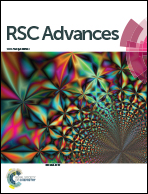Protein adsorption and cellular uptake of AuNPs capped with alkyl acids of different length†
Abstract
The chain length of ligands plays an important role in many biomedical applications. Yet the interaction of nanoparticles with surface-capped ligands of different length (especial the hydrophobic chains) and cells is neglected, and thereby the underlying mechanism influencing cellular uptake is unclear. Herein the role of alkyl length on AuNPs in mediating serum protein adsorption and the subsequent cellular uptake by A549 cells was studied. The AuNPs were modified with carboxylic alkyl thiols of different chain length (3MA, 11MA and 16MA), resulting in MA-AuNPs with a size of 5 nm in dry state and several tens of nm in media. The MA-AuNPs possessed a negatively charged surface, whose zeta potential was around −20 mV in serum-containing medium regardless of the length of ligands. Whereas the total amount of adsorbed serum proteins had no significant difference, the relative amounts of adhesion mediators especially vitronectin (Vn) depended on the alkyl length significantly. The 16MA-AuNPs adsorbed the largest amount of Vn, and were internalized by A549 cells with the largest quantity and good distribution in cytoplasm. Taking account all the results, the protein adsorption and its role in linking alkyl length on AuNPs to cellular uptake are figured out.


 Please wait while we load your content...
Please wait while we load your content...